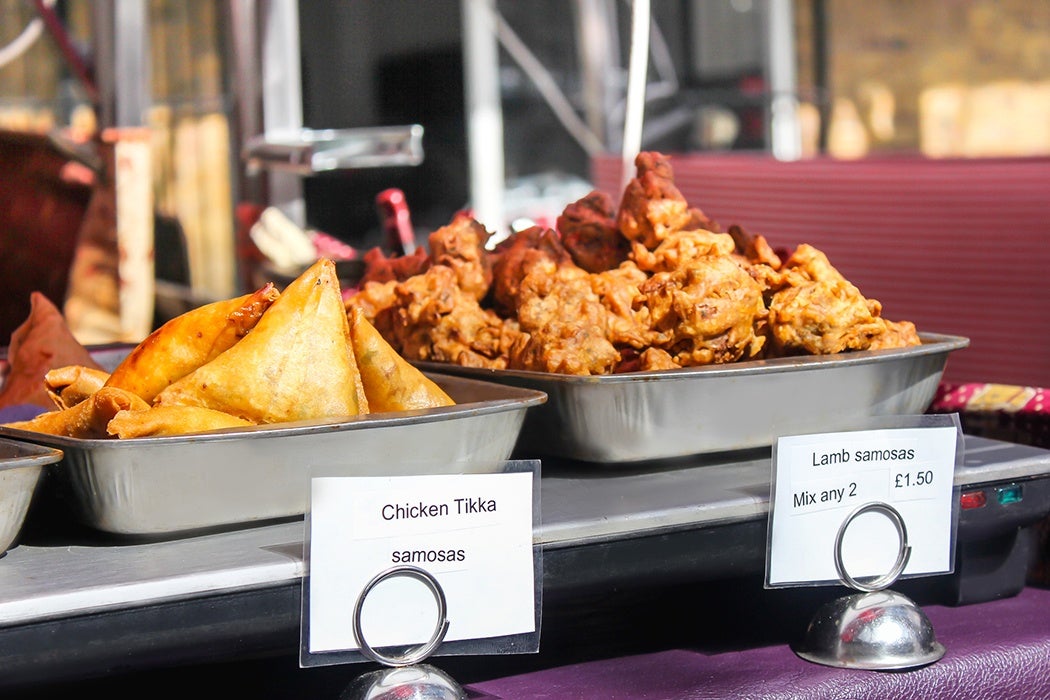In the West, when we think of Indian food, we often think of dishes like Chicken Tikka Masala and kedgeree, both of which were originally created to appease the palates of the British during the Raj. Britain’s late Foreign Secretary Robin Cook once proclaimed that Chicken Tikka Masala was “a true British national dish,” because it was a perfect example of the way Britain absorbed and adapted external influences.
Indian restaurants themselves tell a complicated story of cultural combinations. As scholar Elizabeth Buettner points out, racism kept many Britons from trying curry and other Indian foods until the 1960s when white countercultural youths adopted “going out for curries” as a way to break with their parents’ mores. She also notes that most British Indian food restaurants are “run and staffed by Bangladeshis and Pakistanis; their dishes normally differ markedly from what is consumed in the subcontinent and, for that matter, by most people of South Asian origin in Britain.”
In reality, “Indian food,” much like the country itself, is extremely diverse and dynamic. The various cultures, traditions, and other influences, along with the variable array of ingredients available in different regions, have combined in many ways over the centuries. This has left India with several distinct food cultures that change from one region to the next.
Calcutta
Calcutta, in the Western Bengal region of the country, for instance, has its own cuisine. Because much of the Bengali region is on the coast, recipes tend to use more seafood. The region’s food is also strongly connected to the distinct culture of the area, with certain dishes being associated with particular festivals and times of the year. Gota sheddho, for instance, is a boiled vegetable curry that is often served during prayer rituals called pujas. Puja is the ritual act of showing reverence to a particular deity, and one of the major components of this Hindu tradition is the offering of food (along with prayers, flowers, and other items) to representations of the God in question. Once blessed, devotees also consume a portion of the food.
Gujarat
The northwestern part of India, however, is the region where Gujarati food is most common. Heavily influenced by the Jain religion of the region, Gujarati food is often entirely vegetarian. The sacredness of all life is a major tenant of the Jain religion and so food in this region is often prepared with exquisite care, assuring that no animals, not even insects, are harmed in the harvest or preparation process.
Kashmir
Kashmir has its own food traditions. This area of India, which shares a border with Pakistan, is a center for Muslim culture in the country. It is known for the wide variety of lamb dishes that are native to the region, as well as the liberal use of saffron. One major food tradition here is that of the Wazwan, an epic thirty-six course meal that’s used to celebrate religious festivals, weddings, and other important cultural events.
Just as there is no one India, there is no one Indian food. The Indian food you’re likely to encounter in a Western restaurant is a combination of food and culture from across India, Pakistan, and Bangladesh, with a bit of something extra thrown in (or taken out) to appease the Western palate. But maybe even just the fact that Westerners eat at Indian restaurants is small step toward true multiculturalism. After all, as Buettner writes, Indian food’s “current cultural prominence within national identity followed a history that saw most Britons either ignore or vigorously reject food understood as ‘Indian,’ just as many objected to the arrival and settlement of peoples from the subcontinent.”







